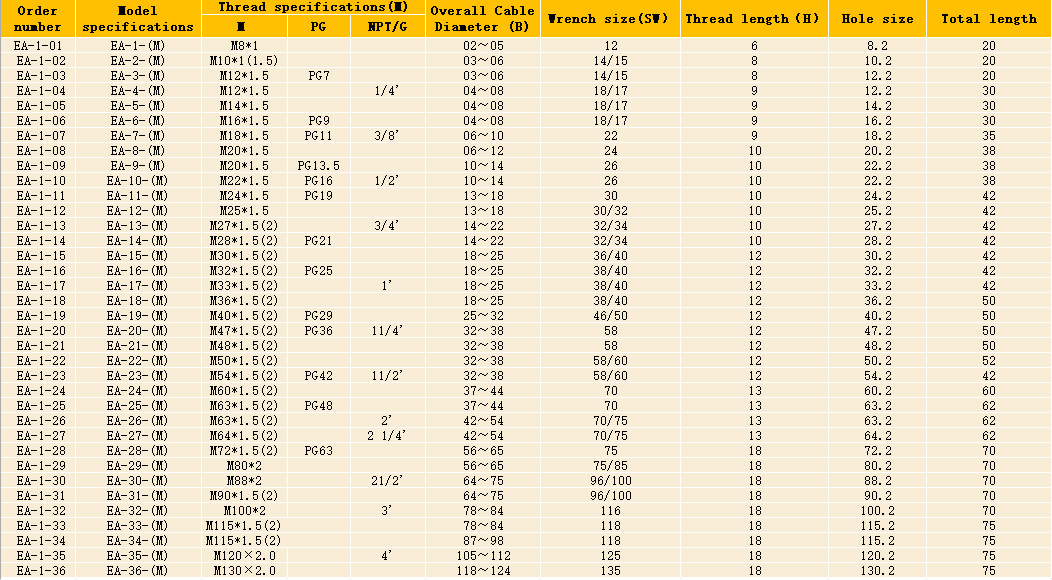Cable Gland Size Chart:
Think of the cable gland size chart as a tool that lets you find the right size for your application. The cable gland size chart uses the overall diameter's nominal dimensions, armor diameter, and cable thickness to help you find the right fit for your cables. This chart is like a calculator for cable gland sizes.
How to use the Cable Gland Size Chart?
Let's navigate the cable gland size chart to find the right cable gland. In the cable gland size chart, each row of the table contains the order number and specification of the cable gland, and each intersecting column corresponds to its parameters, including thread or hole size, etc.
First, we need to determine the cable diameter (mm) and the installation method for the equipment (threaded hole or through hole). Then, in the selection table, locate the corresponding cable sealing connector locking range and thread specification. At this point, the part number and specification on the far left of this row in the table will be the product we need to select. The cable gland size chart ensures that your cable and gland size chart coordinates and that you get the perfect fit for your cables.

Meaning of Letters in Cable Gland Size Chart:
Sometimes, you might find a letter accompanying the number on the cable gland size chart, such as M20. This letter signifies that there is a smaller inner thread-locking system, which is essential for choosing the right kind and size of the cable gland. If you need help selecting the right gland size for your project, consider contacting an expert like BJBON.
How to Measure Cable Glands?
Measuring cable glands is not just a step; it's a crucial part of the process. Whether you're dealing with armored or unarmored cables, the right measurement is key to a secure and reliable connection. Let's demystify the process and learn how to measure cable glands for both types of cables.
Unarmored Cables:
Unarmored cables are fairly easy to measure. The only measurement you require is the diameter of the cable.
Armored Cables:
On the other hand, the armored cables need a few more measurements and considerations. Some of the measurements you require for armored cables include the following:
- Diameter of the inner bedding
- Diameter of the cable's armoring
- Diameter of the lead covering
- Size and type of the armor or braid
- Type and material of the cable armor.
- Short circuit fault current rating
Step-by-Step Guide on Measuring Cable Glands:

Here is a step-by-step guide to help you measure cable glands.
- Identify whether the cable is armored or unarmored.
- For unarmored cables, you need to measure the cable diameter.
- For armored cables, you need to make a few more measurements, including the diameter of inner bedding, armor diameter, lead covering diameter, armor and braid sizes and types.
- For armored cables, you need to measure the circuit fault current rating as well.
- Consider if your application has any specific requirements; check if your cable gland will be threaded or if you need to remove the outer sheath or armor to create a perfect fit.
- Think of other materials you might need for your projects, including earth tags, entry head seals, shrouds, or lock nuts and washers.
- Check if you need any reducers to adapt cable gland size or stoppers to seal any unused cable entries.
Double-check for the Right Cable Gland Size:
Double-checking your work can save you from any unwanted or unnecessary hassle, and hence, it is essential to check whether your measurements for cable gland size are accurate.
To verify your measurements, ask yourself:
- Will all the cables fit into the cable glands' diameter appropriately?
- Is the pressure rating of your gland size accurate for your application?
- Is the cable gland mounting diameter big enough for your cable gland?
- Are the depth and sizes PG, NPT or metric?
Tips for Choosing the Right Cable Gland:
Since there are so many options available, you must be wondering how you can select a cable gland that works perfectly with your application. Consider choosing cable glands from the same manufacturers as the overall system. This will ensure that your cable glands work efficiently with your system.
Choosing products from the same manufacturers will make the process easier as the manufacturers would highlight any considerations and conversions to be considered while measuring for cable glands.
In addition, you should keep the following tips in mind while selecting cable glands:
- Consider the application's purpose. Will it be used in homes, in industries, or commercially?
- Think of where the application will be used, indoors or outdoors. Moreover, consider if it will be exposed to various environmental factors, such as dirt, dust, etc.
- Keep in mind the temperature range and fluctuations in current in the area where the application will be installed.
- It is crucial to assess the atmosphere and take necessary precautions.
Visit BJBON for Cable Glands:
Right cable glands are essential for the safety and efficiency of your electrical systems. Use a cable gland guide and size chart to select the appropriate cable gland for your system. For high-quality cable glands and other electrical components, visit BJBON and explore their range of products. Their expert team is always available to help you through the selection process.

